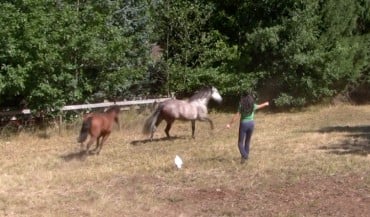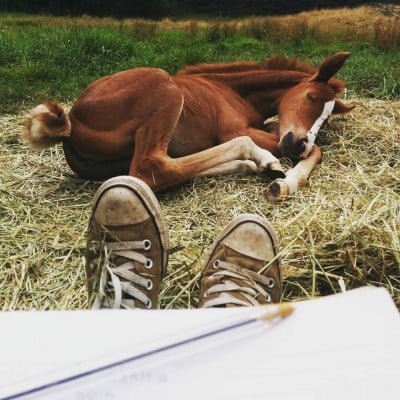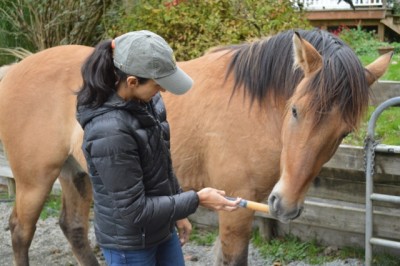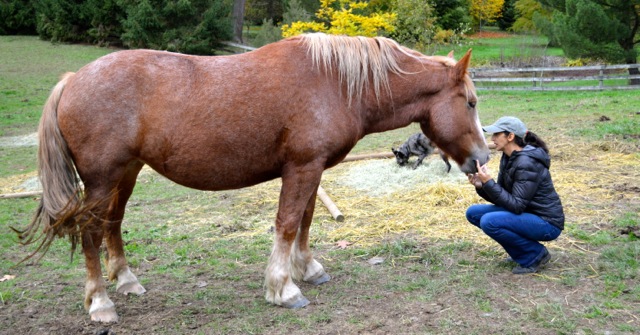
Ray Hunt writes in his legendary book, Think Harmony With Horses:
“For me, the horse doesn’t have to do my thing my way, but I do want him to do my thing his way and like it.”
In theory, this sounds great: You get what you want, the horse is happy, minimal to no pressure needs to be used.
But if a 2-year-old child will eventually cotton on to the fact that you’re zooming him. And if horses are sentient beings; capable of indicating when they want to receive healing and where. And if they’re even more capable at figuring out where we’re f**ed up than a human therapist and then facilitating healing for us… well, HELLO? Don’t you think that horse is also capable of figuring out that he’s being manipulated by you?
And now where is your relationship? Where is your trustworthiness? If you would not manipulate your friend, then maybe you shouldn’t manipulate your horse either.
Training Through Manipulation
Sure, pressure-release works and is gentler than forcing or beating the horse. Negative reinforcement (-R) and manipulative techniques (making the horse think it’s her idea, not yours) also work and are better than whipping, hog-tying, sacking out and various other traditional abusive methods.
But if you want an “I’ve got your back” soul-intimate relationship with your horse, then trustworthiness and honesty have to be in the driver’s seat of everything you do with your horse.
I see “training” (I don’t even like that word) as a collaborative process. First I try to feel into what my horse desires. If I like that too, or agree that’s a good idea, then that’s what we do. If I think it’s not such a good idea (e.g. not safe for me, or not logistically possible) I explain why and then I suggest an alternative, “but how about…” And then she either says, “Yes” or we ping-pong back and forth for a while.
I become childlike and playful in my “training”. Just randomly grabbing ideas from whatever objects are lying around, or whatever chores I’m doing at the time.

- I showed them the towel and let them explore the folded towel thoroughly with lips, teeth, sniffing, etc.
- I unfolded the towel; showing how something small magically becomes big, then back small again. Much blowing and gaping at this magic trick!
- Then I waved the towel gently in the air, then folded it and rubbed their bodies with it
- Then I placed the folded towel (folded into about 1/3 it’s size) over their neck (I was doing each of these steps with each horse and included my domestic Andalusian in the fun too) and then slid it down to their withers and onto their back
- I let each horse walk around with the folded towel on their back for a while
- I unfolded the towel and put it over my head and then lifted up the portion covering my face and laughed, “Hello!” Played peek-a-boo with each of them. Where did she go?? Oh– there she is!
- Then I kept one end of the towel over my head and put the other end over their head – forming a tunnel around us. Moved in for kisses. Slowly pulled the towel over their ears towards me so they were free and I was covered. Then, peek-a-boo! Oh my gosh, they are LOVING all this playful fun. I’m crazy, but I’m fun!
- Next I unfold the towel to it’s full length and gently toss it onto their back. Let them walk around with it, then slide it off and throw it on the next horse. Ask them to follow me around, walking, then trotting with the towel on their back. Then I slide if off over their bum.
- Now I’m tired, so I fold the towel up and sit on it again. They graze peacefully around me
How’s that for a “desensitization” and a saddle-pad precursor training session?
Or you can do it this way. This way is considered to be the gentle, natural horsemanship way (and Daryl Gibb studied personally with Ray Hunt before he passed). As you can see, this way works too and the horse is not being hurt. But how much fun are horse and human having?:
Cause here’s the totally fabulous part: YOU get to choose what “hanging out” with your horse looks like! Personally, I find codified training processes/techniques boring as hell. If that was the only way to get a horse to enjoy being ridden, I would outsource it, no question. Or, more likely, I would give up on riding.
Which actually brings up another important question: Do you want a horse who is ridable? Or do you want a horse who ENJOYS being ridden – who comes to get you and says, “C’mon, let’s go for a ride!”
When my 9-year-old Andalusian, Zorra, arrived, she had only been ridden a total of 5.5 months in her entire life. I was thrilled, because not only was her spine in excellent shape from not being mutated before the growth plates hardened (occurs at age 6-7), but she also had less negative stuff for me to undo.
I waited – just playing with her and having her respond to voice and hand signals from the ground for SIX MONTHS. Why? Because I was waiting for her to ASK me to get on her back.
This finally happened one day when we’d gone on a 2 hour hike in a park. I’d run beside her as much as I could (I’m not a runner!) and she got frustrated that I couldn’t run faster, and we couldn’t trot for longer. “Well, Zorra, if you let me ride you, then we could trot and canter for as long as you like!” And then at the end of 2 hours when we were heading home, she stopped on the road and said, “I don’t want to go home, let’s go back in the park again.”

Zorra said, “Well… then… get on my back!”
“Oh, what’s that?” I replied teasingly, “Are you actually inviting me to ride? Well all right then!”
I tied the lead rope into reins and my friend gave me a boost onto her back. Once I was up there, bareback, Zorra just headed for home. I said, “Yep, that’s a good idea, let’s just start with a little ride.” And so we began.
Since then, she has shown me how my right and left side are completely unbalanced!
She has also told me that my sitz bones press painfully into her spine – yet she doesn’t want to wear a bareback pad because she hates the cinch (which I totally sympathize with as I refuse to wear a bra for the same reason). So now I am working on prototypes for butt padding (cut out of closed-cell foam yoga mats) that I can pull on over my pants. And so on.
So the friendship, trust, dialogue and negotiation doesn’t end with riding – it just continues.
Zorra now LOVES going for 2-3 hour rides in our local 300 acre park. When we turn onto the trail, her Spanish walk comes to life and she goes into natural collection – not because I’m hauling on her mouth (I give her the choice of a bitless bridle or rope halter and she always chooses the rope halter), but because she is infused with the exuberance of life and adventure. She becomes bold and wants to explore new trails, her entire body pulses with the joy of LIFE coursing through it.
And I get to join her in that. Our bodies get to merge in this enlivening experience of life-force energy. We are totally connected and in total trust with each other. I’ve got her back, and she’s got mine. And that is what “riding” means to me. Obviously, this can only happen if the horse is operating from free will and a liberated soul.
So sure, you can get a horse that’s ‘broke to ride’ and that will comply with all the aids you give it (more or less) and that’s one way of being with a horse.
Or you can be in an intimate, authentic relationship with your horse. Where it’s often confusing, or messy, or gloriously magnificent, or heartbreaking, or bursting with joy, or crying in the rain together, or healing, or enlightening. But through it all is connection and bedrock trust.
But My Horse MUST Do X
What about those times when your horse needs to endure some painful, or uncomfortable, or frightening thing – just because that’s what happens in the human world? Trailering, injections, worming, dental work come immediately to mind. What then?

Also do your research as to whether that procedure actually is in the horse’s best interest. So many of the things we do and give to horses are very damaging to their bodies (eg. administering bute) and we would be much better off to look for the root cause and resolve that.
And maybe your horse would be okay with a hand float, but is begging you not to do the power tooth float because your horse knows the heat and force are weakening his teeth (inducing micro-fractures) and the angle is wrong; leaving him with an incorrect bite that then takes him months to get comfortable chewing again.
Only in extreme circumstances will I say, “You gotta trust me and we’re doing X. You can’t understand this now, but you will later and even though it’s going to be yucky or scary etc. you’ve got to trust me”.

This is exactly what happened when I asked my purebred Belgian mare, Audelina, to get into a cramped trailer to move to our new pasture. There were NO other options. We had to leave the boarding place we were at (they got new horses and there wasn’t enough room for everyone), and I could not walk her over to the new pasture.
OMG that was one of the hardest things she’s ever done and she was literally covered with sweat over every inch of her body when we got there 15 minutes later.
But I was honest with her: “Yes, this completely sucks. I would not choose to put you in here either, but there IS no other trailer available! And we’ve been kicked out of this place and we MUST move to the new place and TRUST me, it will be worth the pain. I can’t make it easier, I can’t make it better. All I can promise you is that it will be worth it.”
So yes, I had to use some pressure to get her in that trailer (tapping on the bum and and an ingenious arena panel chute system) because she needed me to use that amount of pressure to help her press through her own fear and resistance. I will be very interested to see how she responds to the next trailer – the custom 8′ high stock trailer I’m going to buy!
However, I took responsibility for that experience and did an EFT Tapping session with her both before and afterwards to clear the trauma of that trailer ride and the other 3 trailer rides she’s been on in her life. So again, even though I used pressure and didn’t really give her a choice about getting in the trailer (her only choice was when she got in the trailer), the fact that I stayed present/conscious, was honest about the yuckiness and did whatever I could before and after to help her process the emotional, psychological and physical pain – she still knew that I was on her side. That I’ve ‘got her back’.
Like any relationship, trust is pretty much #1 – and that doesn’t change across species!
Trust is usually broken because the human thinks the animal is not fully sentient and therefore cannot understand what is happening. Wrong. My horse knows my mankiness, warped motives and unconscious drivers better than I do! Remember, that’s why they’re so successful with Equine Therapy.
Thank god they’re also wise and forgiving too.

Jini Patel Thompson is a natural health writer and Lazer Tapping instructor. She began riding at age 2 in Kenya, and got her first horse at age 8 in Alberta, and so continues a life-long journey and love affair with these amazing creatures.








